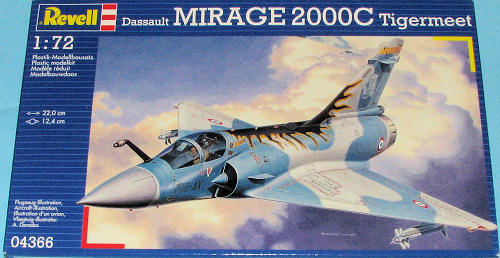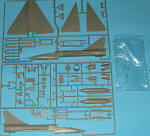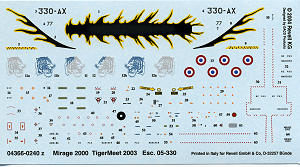Revell AG 1/72 Mirage 2000C
| KIT #: | 04366 |
| PRICE: | $20.25 MSRP ($17.20 at GreatModels) |
| DECALS: | One option |
| REVIEWER: | Scott Van Aken |
| NOTES: | Reboxed Italeri kit. 2004 edition |

The French Air Force developed a requirement for the Avion de Combat Futur (ACF) (French: "Future combat aircraft") in the early 1970s.Dassault offered its twin-engine Super Mirage for the ACF requirement. However, the Super Mirage was to be too costly and was canceled in 1975. Dassault offered the single-engine Mirage 2000 as an alternative and was given approval to proceed by the French government on 18 December 1975. This was a return to the first generation Mirages, but with several important innovations that tried to solve their shortcomings. Project chiefs were B.C. Valliéres, J.Cabrière, J.C. Veber and B.Revellin-Falcoz.
Development of this small aircraft would also give the company a competitor to the General Dynamics F-16 Fighting Falcon, which had defeated the Dassault Mirage F1 in a contest for a new fighter for the air forces of Belgium, Denmark, Netherlands and Norway. Small single-engined fighters were clearly the most appreciated by foreign customers, as experience with the larger, twin-engined Mirage 4000 would show.
The prototype made its first flight in 10 March 197] with test pilot Jean Coreau at the controls. Despite the new technologies applied, basing the new aircraft on the Mirage III allowed the development of a prototype in only 27 months from the program start to the first flight.In that summer, at the Farnborough Air Show, this machine displayed not only excellent handling capabilities, but also a full control at 204 km/h and 26 degree angle of attack. This was totally unexpected in a delta-wing fighter, and proved how CCD controls were capable of overcoming the delta wing shortcomings related to poor low-speed control, while retaining the advantages, such as low-drag, low radar cross section, ideal high speed aerodynamics and simplicity, provided by the absence of horizontal tail surfaces. The Mirage 2000 was one of the stars of that air show and became the direct adversary for the F-16, which shared the CCD control and relaxed stability. The 02 Prototype followed in 18 September 1978 and 03 in 26 September 1979. After 400 hours of flight, they were sent to CEV (Centre d'Essais en Vol). The 04 Prototype was a demonstrator made by Dassault for its own purposes, and finally the first dual-seat Mirage 2000B flew in 11 October 1980.
The first production example flew on 20 November 1982, and the aircraft went into operational service in November 1982.They were practically pre-production aircraft, because they had no SARH missiles (RDM-1 radar) and the first model of SNECMA 'Super Atar' M-53-2.The Mirage 2000 production line was shut down in 2007 after the last aircraft was delivered. The last Mirage 2000 was delivered on 23 November 2007 to the Hellenic Air Force. Over 600 aircraft were built and it is in service in nine countries as of 2009.
 As the package states 'Made in Italy', I'm going to assume this is a reboxed Italeri kit. The only other Mirage 2000 kit I can think of off the top of my head that isn't resin or short run is the Heller kit. That one was a bear to build due to the poor intake fit and I built a pair of them. This one looks to be a much nicer build, though not surprisingly, the parts breakdown is pretty much the same as with the older Heller kit.
As the package states 'Made in Italy', I'm going to assume this is a reboxed Italeri kit. The only other Mirage 2000 kit I can think of off the top of my head that isn't resin or short run is the Heller kit. That one was a bear to build due to the poor intake fit and I built a pair of them. This one looks to be a much nicer build, though not surprisingly, the parts breakdown is pretty much the same as with the older Heller kit.
The kit comes on two grey and one clear sprue. The clear sprue has a separate canopy and windscreen so that it can be posed open. The rest of the kit is your standard engraved plastic with the detailing being a bit softer than what you'd get with, say, a Hasegawa kit. By that I mean the edges of the engravings are more rounded than squared off.
The Mirage 2000 is not a kit festooned with all sorts of stuff so the basic airframe is pretty simple to build. There is a nice multi-piece cockpit with raised instrument and switch detailing. The three piece ejection seat is fairly well done, but like all jet kits, a more detailed resin replacement will really help. There are holes in the lower wing to open if you want to carry a full load of missiles as there are racks on the lower fuselage to be installed. You can, of course, leave those off. Slots for the wing pylons are already made for you. The nose needs 20gms of weight to prevent tail sitting.
I dare say a goodly proportion of the parts are for various weapons and drop tanks. I'm totally ignorant when it comes to French  weapons, but those supplied look good. You have two styles of centerline tank that can be use; one without rear fins.
weapons, but those supplied look good. You have two styles of centerline tank that can be use; one without rear fins.
Instructions are typical Revell; well drawn and using only Revell paints. That means the exterior colors will need to be mixed or you can get the proper shades from Colourcoats or Xtracolor paints (to name a couple of brands that do French AF shades). Markings are for one aircraft, the box art plane from Tiger Meet 2003. It is with EC 5/330, the test unit at Mont-de-Marsan. These markings are rather simple as Tiger Meet markings go. Decals are well printed and matte. You get several options on the tiger fin markings, depending on how you end up doing the camo scheme. A nice touch .
So far, this one has my vote as best 1/72 mainstream Mirage 2000C kit, especially after building the Heller versions. It should prove to make into a very nice model.
http://en.wikipedia.org/wiki/Mirage_2000March 2010
You can find this and many other kits and accessories at GreatModels
If you would like your product reviewed fairly and fairly quickly, please contact the editor or see other details in the Note toContributors.
Back to the Main Page
Back to the Previews Index Page


 As the package states 'Made in Italy', I'm going to assume this is a reboxed Italeri kit. The only other Mirage 2000 kit I can think of off the top of my head that isn't resin or short run is the Heller kit. That one was a bear to build due to the poor intake fit and I built a pair of them. This one looks to be a much nicer build, though not surprisingly, the parts breakdown is pretty much the same as with the older Heller kit.
As the package states 'Made in Italy', I'm going to assume this is a reboxed Italeri kit. The only other Mirage 2000 kit I can think of off the top of my head that isn't resin or short run is the Heller kit. That one was a bear to build due to the poor intake fit and I built a pair of them. This one looks to be a much nicer build, though not surprisingly, the parts breakdown is pretty much the same as with the older Heller kit. weapons, but those supplied look good. You have two styles of centerline tank that can be use; one without rear fins.
weapons, but those supplied look good. You have two styles of centerline tank that can be use; one without rear fins.